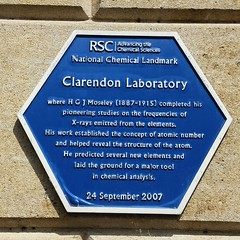Henry Moseley


Henry Moseley
(1887-1915)
Commemorated on 2 plaques
National Chemical Landmark: Clarendon Laboratory where H. G. J. Moseley (1887-1915) completed his pioneering studies on the frequencies of X-rays emitted from the elements. His work established the concept of atomic number and helped reveal the structure of the atom. He predicted several new elements and laid the ground for a major tool in chemical analysis.
Sherrington Road, Oxford, United Kingdom where they completed his pioneering studies on the frequencies of X-rays emitted from the elements
The family home of Henry Gwyn Jeffreys Moseley (1887-1915) who established the atomic numbers of the chemical elements. Killed in action at Gallipoli
48 Woodstock Road, Oxford, United Kingdom where they lived


